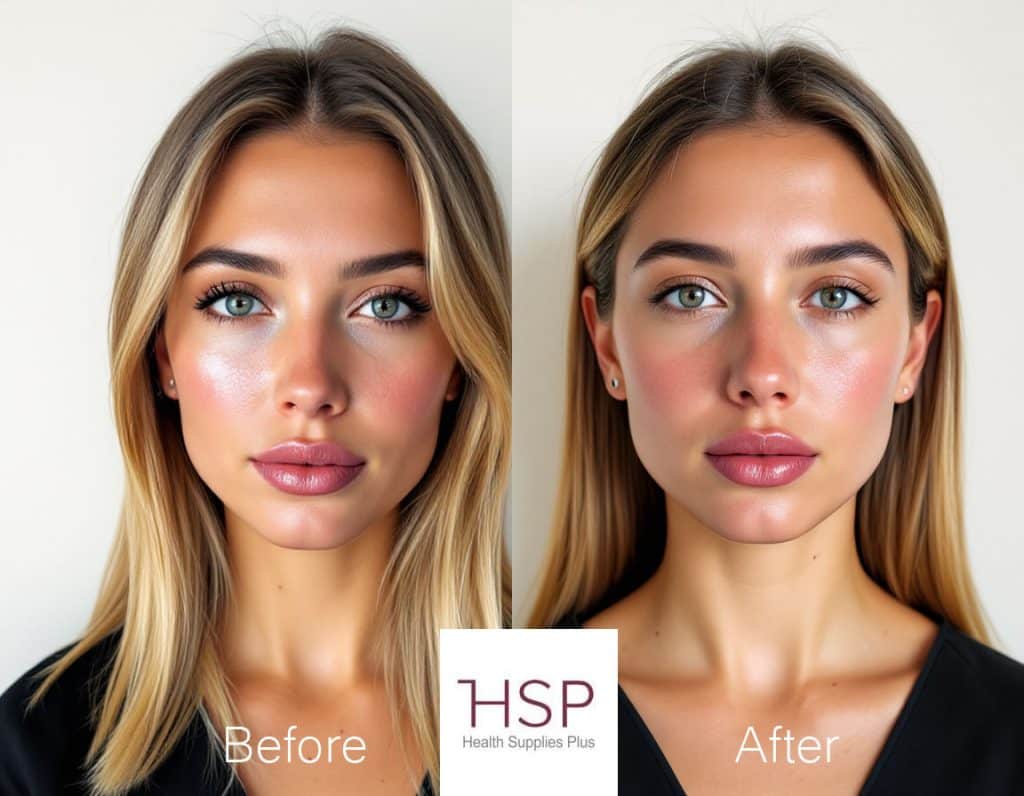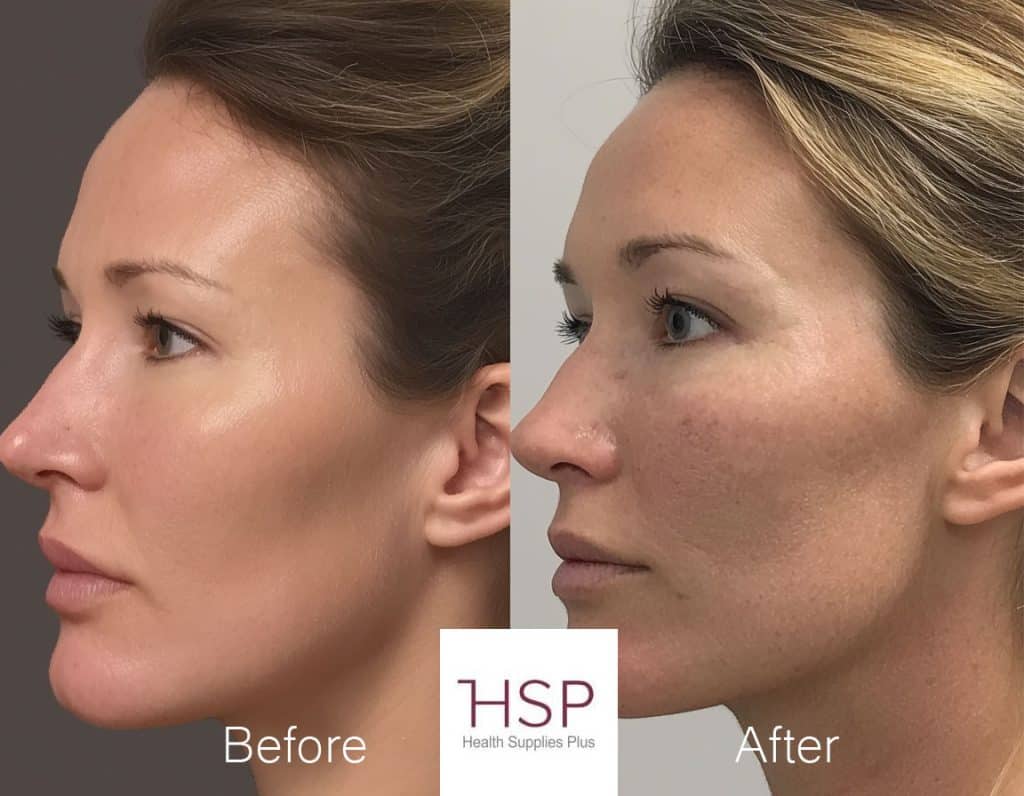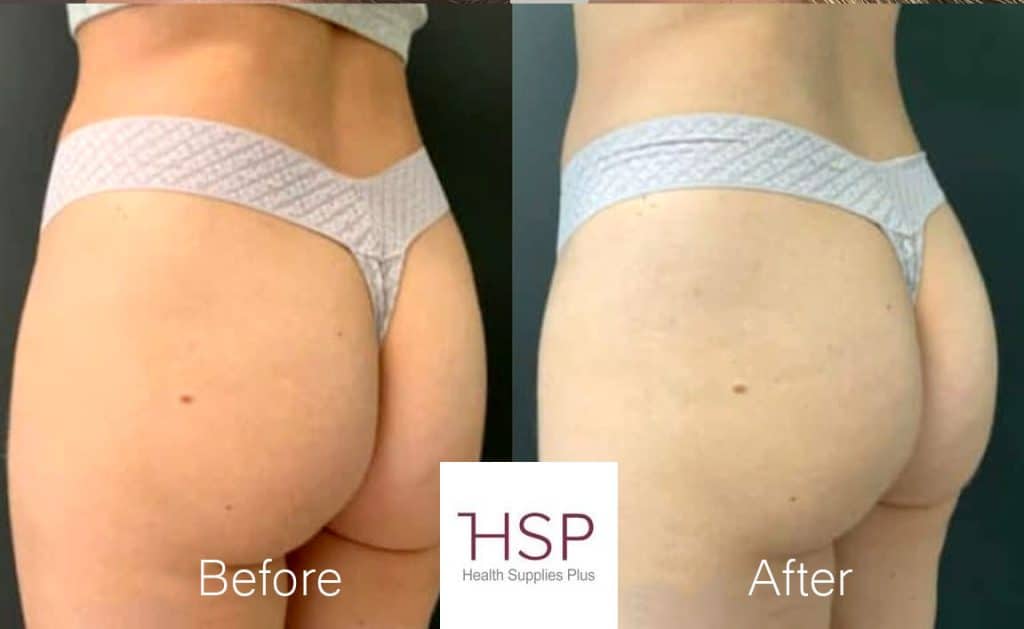
This comprehensive guide details everything a practitioner needs to know about a Sculptra treatment, from facial and body applications to dosing and clinical considerations. Whether you are an experienced provider or new to PLLA biostimulation, this resource will help you make informed decisions for your practice and your patients.
Table of Contents
- Cost of a Sculptra Treatment & Pricing Factors
- Sculptra Treatment vs. Other Dermal Fillers
- Popular Applications for a Sculptra Treatment
- Sculptra® Before and After Results
- A Clinical Guide to Dosing
- For Medical Professionals: Clinical Considerations
- Disadvantages & Risks of a Sculptra Treatment
- Who is a Candidate for a Sculptra Treatment?
- Conclusion
- Frequently Asked Questions
Cost of a Sculptra Treatment: What You Need to Know
When it comes to the cost of a Sculptra treatment, several important factors must be considered. Sculptra is generally priced per vial, with each vial containing 367.5mg of PLLA powder that must be reconstituted with sterile water before injection. The average cost per vial of Sculptra can range from $700 to $900, with most patients requiring between two to four vials per treatment.
Compared to other dermal fillers, a Sculptra treatment can be more expensive upfront but may offer longer-lasting results. For example, while hyaluronic acid (HA) fillers like Juvederm or Restylane may cost between $500 to $800 per syringe and provide results that last six to twelve months, Sculptra may cost more per session but can last for two years or longer. Factors that influence the final cost include the treatment area, the total number of sessions required, geographic location, and the provider’s experience level.
Sculptra Treatment vs. Other Dermal Fillers
Understanding how Sculptra’s PLLA biostimulation mechanism differs from other popular injectables is key to selecting the best treatment for your patients.
Sculptra® vs. Botox®: Which is Right for Your Patient?
While both are top-tier injectables for facial rejuvenation, Sculptra and Botox are fundamentally different tools for different jobs. They are not interchangeable. In short, Sculptra rebuilds lost facial structure, while Botox relaxes muscles that cause expression lines.
| Feature | Sculptra® (The Volumizer & Builder) | Botox® (The Muscle Relaxer) |
|---|---|---|
| Primary Function | Biostimulator | Neurotoxin / Neuromodulator |
| Main Ingredient | Poly-L-Lactic Acid (PLLA) | Botulinum Toxin Type A |
| Mechanism of Action | Stimulates the body’s own natural collagen production over several months. | Temporarily blocks nerve signals to specific muscles, preventing contraction. |
| Best For Treating | Static wrinkles & volume loss: Deep folds (nasolabial), sunken cheeks, temple hollowing, jowls, and overall skin laxity. | Dynamic wrinkles: Frown lines (“11s”), forehead lines, crow’s feet caused by facial expressions. |
| Onset of Results | Gradual. Visible improvements over several months as collagen builds. | Quick. Initial results in 3-5 days, full effect by 2 weeks. |
| Duration of Effect | Long-lasting: 2+ years after the initial treatment series is complete. | Temporary: 3-4 months on average. |
| Treatment Protocol | A series of 2-4 sessions, spaced 4-8 weeks apart. | A single session, repeated every 3-4 months for maintenance. |
The Clinical Bottom Line for Practitioners: Sculptra and Botox are not competitors; they are complementary. For a patient concerned with expression lines, Botox is the correct choice. For a patient presenting with volume loss and a “tired” look due to thinning skin, the Sculptra treatment is the superior solution.
Sculptra® vs. Juvéderm Voluma®: A Comparison for Practitioners
The primary difference is simple: Sculptra is a collagen biostimulator that prompts the body to rebuild its own volume, while Juvéderm Voluma is a hyaluronic acid (HA) filler that physically adds immediate volume.
| Feature | Sculptra® (The Collagen Builder) | Juvéderm Voluma® (The HA Volumizer) |
|---|---|---|
| Primary Function | Collagen Biostimulator | Volumizing Dermal Filler |
| Main Ingredient | Poly-L-Lactic Acid (PLLA) | Cross-linked Hyaluronic Acid (HA) |
| Mechanism of Action | Stimulates fibroblasts to produce new Type I collagen, gradually restoring the skin’s inner structure. | A smooth, viscous gel that physically lifts and contours the tissue upon injection, providing immediate volume. |
| Best For Treating | Global volume loss, skin laxity, and restoring structure in areas like the temples, cheeks, and jawline. Excellent for improving overall skin quality. | Targeted lift and contouring, especially for creating definition in the upper cheeks and mid-face to achieve an “apple cheek” appearance. |
| Onset of Results | Gradual, with results appearing over 4-6 months as collagen develops. | Immediate, with final results visible after initial swelling subsides. |
| Duration of Effect | Up to 2+ years after the initial treatment series. | Up to 2 years. |
| Reversibility | Not directly reversible. | Reversible with the enzyme hyaluronidase. |
The Clinical Bottom Line for Practitioners: For a patient who needs immediate, targeted lift in the cheeks, Juvéderm Voluma is the ideal choice. For a patient with widespread facial thinning seeking natural, gradual improvement, a Sculptra treatment is the superior option.
Sculptra® vs. Radiesse®: Choosing the Right Biostimulator
The key difference lies in their composition and immediate effect: Radiesse provides an instant lift with its gel carrier which is then followed by collagen stimulation, while Sculptra works purely as a biostimulator for gradual, natural-looking results.
| Feature | Sculptra® (The Gradual Builder) | Radiesse® (The Instant & Long-Term Builder) |
|---|---|---|
| Primary Function | Pure Collagen Biostimulator | Dermal Filler + Collagen Biostimulator |
| Main Ingredient | Poly-L-Lactic Acid (PLLA) | Calcium Hydroxylapatite (CaHA) |
| Mechanism of Action | PLLA microparticles stimulate a gradual, natural collagen response over several months to restore volume. | CaHA microspheres suspended in a gel carrier provide immediate volume, followed by long-term collagen stimulation. |
| Best For Treating | Widespread volume loss in cheeks and temples, improving overall skin quality and laxity, and non-surgical butt lifts. | Deep folds like nasolabial folds, and adding structure to the jawline and chin. Also FDA-approved for hand rejuvenation. |
| Onset of Results | Gradual, with full results developing over several months. | Immediate correction from the gel, with continued improvement over time as collagen builds. |
| Duration of Effect | Up to 2+ years. | Up to 15+ months. |
| Reversibility | Not directly reversible. | Not directly reversible with an enzyme. |
The Clinical Bottom Line for Practitioners: If a patient requires an instant correction of deep folds or a more defined structural lift, Radiesse is an excellent choice. If the primary goal is to address diffuse volume loss with natural, gradual results, the Sculptra treatment is the ideal solution.
Popular Applications for a Sculptra Treatment
The Sculptra® Butt Lift (BBL): A Non-Surgical Alternative
The Brazilian Butt Lift (BBL) is highly sought-after, but not all patients are candidates for surgical fat grafting. For those who lack donor fat, wish to avoid surgery, or desire a more subtle enhancement, the Sculptra Butt Lift is a revolutionary non-surgical alternative.
How Does the Sculptra BBL Work?
Instead of adding volume with fat, Sculptra’s PLLA microparticles are injected deep into the buttocks, triggering a controlled inflammatory response that stimulates the body to produce new Type I collagen. This new collagen framework gradually builds up over several months, adding natural-looking volume, improving contour, and tightening the overlying skin. This specific Sculptra treatment is known for its natural results.
Ideal Candidates and Treatment Protocol
The ideal candidate desires subtle, natural enhancement and wishes to avoid surgery. The treatment typically involves a series of 2-3 sessions, spaced 4-8 weeks apart, with 4-6 vials of Sculptra per session. A meticulous injection technique combined with patient adherence to the “Rule of 5s” massage (massage for 5 minutes, 5 times a day, for 5 days) is critical for optimal results and to minimize risks.
Sculptra® for Facial Rejuvenation: The Biostimulatory Approach
True facial rejuvenation often requires rebuilding the underlying structural support lost with age. A Sculptra treatment addresses this core issue by using PLLA to harness the body’s own regenerative power, gradually restoring volume and improving skin quality for a remarkably natural result.
Mechanism and Ideal Treatment Areas
Sculptra works by triggering neocollagenesis (the creation of new collagen) in the deep dermis. Ideal treatment areas include temple hollowing, nasolabial folds, cheek volume loss, and contour deficiencies along the jawline. It should not be injected into the lips or superficially around the eyes, as this increases the risk of nodules.
The Treatment Process
Success with Sculptra hinges on a multi-session approach (typically 2-4 sessions, 4-8 weeks apart) and clear patient communication about the gradual onset of results. For safety and efficacy, Sculptra must be injected into the deep dermis or subcutaneous tissue. The patient’s adherence to the “Rule of 5s” post-treatment massage is non-negotiable for success.
Sculptra® for Masculine Enhancement
The male aesthetic market is rapidly expanding, with men seeking treatments that enhance features while preserving a natural, masculine appearance. Sculptra is uniquely suited for this demographic as it rebuilds structural support by promoting the body’s own collagen, restoring a youthful, defined look without the risk of an “overdone” or feminized result. This type of Sculptra treatment is ideal for subtle enhancement.
Key Considerations for Treating Male Patients
Achieving successful outcomes in men requires a tailored approach that respects their distinct anatomy, including thicker skin and more angular bone structure. The goal is often to restore volume in the temples and mid-face to correct a “hollow” look and to enhance the definition of the jawline and cheekbones. The gradual, subtle nature of Sculptra’s results is a significant advantage for male patients.
Sculptra® for Body Contouring
Beyond the face, experienced practitioners use hyperdiluted Sculptra to improve skin laxity and texture on the body. This off-label application involves reconstituting the PLLA powder with a larger volume of sterile liquid to create a more spreadable consistency suitable for broad areas like the abdomen, thighs, and arms. A Sculptra treatment for the body can be highly effective for the right candidate.
Applications and Clinical Considerations
Ideal candidates have mild to moderate skin laxity or cellulite. The goal is not dramatic augmentation but foundational improvement of the skin’s structural integrity. Practitioners must recognize that body treatments require significantly more product volume per session and advanced injection techniques, often with blunt-tip cannulas, to ensure safety and even distribution. The post-treatment massage protocol is absolutely critical over these larger surface areas.
What to Expect: Sculptra® Before and After Results
Managing patient expectations is one of the most critical aspects of a successful Sculptra® treatment. Unlike hyaluronic acid fillers that provide immediate volume, Sculptra works gradually to stimulate the body’s own collagen-building process (neocollagenesis). A successful consultation involves explaining this journey from “before” to “after.”
The “Before” State: Identifying the Ideal Candidate
The typical “before” state for an ideal Sculptra candidate is not defined by sharp, individual lines, but rather by the subtle, global signs of facial aging. Practitioners should look for:
- Generalized volume loss, particularly in the mid-face, temples, and pre-auricular areas, leading to a “drawn” or tired appearance.
- Loss of structural support along the jawline, resulting in the early formation of jowls.
- Skin laxity and thinning, where the skin has lost its youthful firmness and “snap.”
- Contour deficiencies in the body, such as hip dips or a lack of projection in the buttocks for a Sculptra BBL.
The Treatment Journey: From Initial Fullness to Final Result
The transformation with Sculptra occurs over several months and multiple sessions. It’s crucial to explain this timeline to your patients:
- Immediately Post-Injection: Patients will see an immediate plumping effect. It is essential to explain that this is primarily due to the sterile water used to reconstitute the product and will subside in a few days as the water is absorbed. This is NOT the final result.
- The “Collagen Building” Phase: Over the next 4-6 weeks, the PLLA microparticles begin to stimulate the body’s fibroblasts. This is the quiet phase where the new dermal scaffolding is being built beneath the skin’s surface.
- Subsequent Sessions: Each treatment session (typically 2-3 are required) builds upon the collagen foundation laid by the previous one, gradually layering volume and structure for a natural-looking outcome.
The “After” State: The Natural-Looking Outcome
The final “after” result, typically visible 4-6 months after the last treatment session, is not one of being “filled,” but of being restored. The outcome should be a natural and harmonious rejuvenation, characterized by:
- Restored facial volume that looks and moves naturally with the patient’s own tissue.
- Improved skin quality, including increased firmness, thickness, and a healthy glow.
- Softened folds and wrinkles, as the underlying structural support has been rebuilt.
- Enhanced, natural contours in the cheeks, jawline, or buttocks.
Visualizing the Results: Before and After Examples
The most effective way to communicate the potential of Sculptra is through visual evidence. Below are examples of typical outcomes for common treatment areas.
Mid-Face and Cheek Volumization
Notice the subtle lift and restoration of the natural “apple” of the cheek, reducing the appearance of nasolabial folds and creating a less tired look.

Jawline Contouring and Jowl Softening
By rebuilding the structural support in the pre-auricular area and along the mandible, Sculptra can create a sharper, more defined jawline and soften the appearance of early jowls.

The Non-Surgical Sculptra BBL
In the buttocks, Sculptra adds volume and projection while also improving skin texture and reducing the appearance of cellulite, resulting in a subtle but significant lift and improved shape.

How Much Sculptra is Needed? A Clinical Guide to Dosing
Unlike HA fillers dosed per syringe, Sculptra dosage is a comprehensive strategy. A widely used clinical rule of thumb is to start with one vial of Sculptra for each decade of a patient’s age (e.g., a 50-year-old might be a candidate for a total of 5 vials, distributed over 2-3 treatment sessions).
Key Factors Influencing Sculptra Dosage
The precise number of vials and sessions required for a Sculptra treatment depends on the severity of volume loss, the size of the treatment area, the patient’s aesthetic goals, and their age and skin condition.
General Dosing Guidelines per Treatment Area
The following are common treatment plans, showing how the total vial count is typically distributed across multiple sessions.
| Treatment Area | Typical Vials per Session | Total Recommended Sessions |
|---|---|---|
| Cheeks / Mid-Face | 2-3 vials | 2-3 sessions |
| Temples | 1-2 vials | 2 sessions |
| Jawline | 1-2 vials | 2 sessions |
| Nasolabial Folds | 1 vial | 1-2 sessions |
| Chin | 1 vial | 1-2 sessions |
For Medical Professionals: Clinical Considerations & Advanced Techniques
Achieving safe, predictable, and highly satisfactory results with Sculptra® requires a mastery of its unique properties, from tool selection to combination therapy.
Injection Technique: Cannula vs. Needle
- Cannulas (Generally Preferred for Volume): A blunt-tip cannula is often favored for treating larger areas, as it can be fanned out from a single entry point to distribute product evenly, significantly reducing the risk of bruising and vascular events.
- Needles (Ideal for Precision): Needles offer superior control for precise, small-volume injections, making them excellent for targeted application in areas like the nasolabial folds.
Combination Therapy: Enhancing Results
Sculptra is an exceptional foundational treatment, often combined with other modalities. When used with HA fillers, Sculptra rebuilds deep structure while the HA filler provides immediate, superficial correction. When used with neuromodulators like Botox®, a practitioner can achieve a full-face rejuvenation by addressing both volume loss and dynamic wrinkles.
Patient Management: Pre- and Post-Treatment Protocols
Consistent protocols are key. This includes a thorough pre-treatment consultation to set realistic expectations and critical post-treatment care. The patient must be instructed to perform the “Rule of 5s” massage: massage the treated areas for 5 minutes, 5 times a day, for 5 continuous days. This is the most crucial step in preventing nodules.
Disadvantages & Risks of a Sculptra Treatment
While generally safe, providers and patients must be aware of potential disadvantages of a Sculptra treatment. The primary risk specific to Sculptra is the formation of small, subcutaneous lumps or nodules, which can occur if the product is not injected correctly or if the patient fails to follow the aftercare massage protocol. Other risks include the standard injection-related side effects like swelling, bruising, and, rarely, infection. A notable disadvantage for some patients is the delayed onset of results, as the collagen-building process takes several months. It’s also crucial to note that Sculptra is not reversible with an enzyme like HA fillers are.
Who is a Candidate for a Sculptra Treatment?
Ideal candidates for a Sculptra treatment are individuals in good health experiencing age-related volume loss who have realistic expectations and are committed to the multi-session treatment process and aftercare. Patients with active skin infections or inflammation in the treatment area, a known allergy to any of the product’s ingredients, or a history of keloid or hypertrophic scarring should not receive Sculptra. The treatment is also not recommended for women who are pregnant or breastfeeding.
Conclusion
Sculptra® Aesthetic stands as a premier biostimulatory injectable, offering a unique and powerful approach to facial and body rejuvenation. By harnessing the body’s own collagen-building mechanisms, it delivers gradual, natural-looking, and remarkably long-lasting results. For the medical professional, success with any Sculptra treatment is rooted in a deep understanding of its properties—from its gradual onset and multi-session protocol to the critical importance of aftercare. For more information, practitioners can refer to the official Sculptra® website. By mastering the clinical considerations, practitioners can leverage Sculptra to provide exceptional care and achieve outstanding aesthetic outcomes.
Sculptra: Frequently Asked Questions

About the Author: Doris Dickson is a specialist writer for Health Supplies Plus, focusing on the aesthetic medicine industry. She diligently researches cosmetic treatments and products to provide clear, concise information relevant to licensed medical professionals. Her work supports Health Supplies Plus’s commitment to being a reliable informational resource and trusted supplier for the aesthetic community.
Disclaimer: The content provided in this article is intended for informational purposes only and is directed towards licensed medical professionals. It is not intended to be a substitute for professional medical advice, diagnosis, or treatment, nor does it constitute an endorsement of any specific product or technique. Practitioners must rely on their own professional judgment, clinical experience, and knowledge of patient needs, and should always consult the full product prescribing information and relevant clinical guidelines before use. Health Supplies Plus does not provide medical advice.
